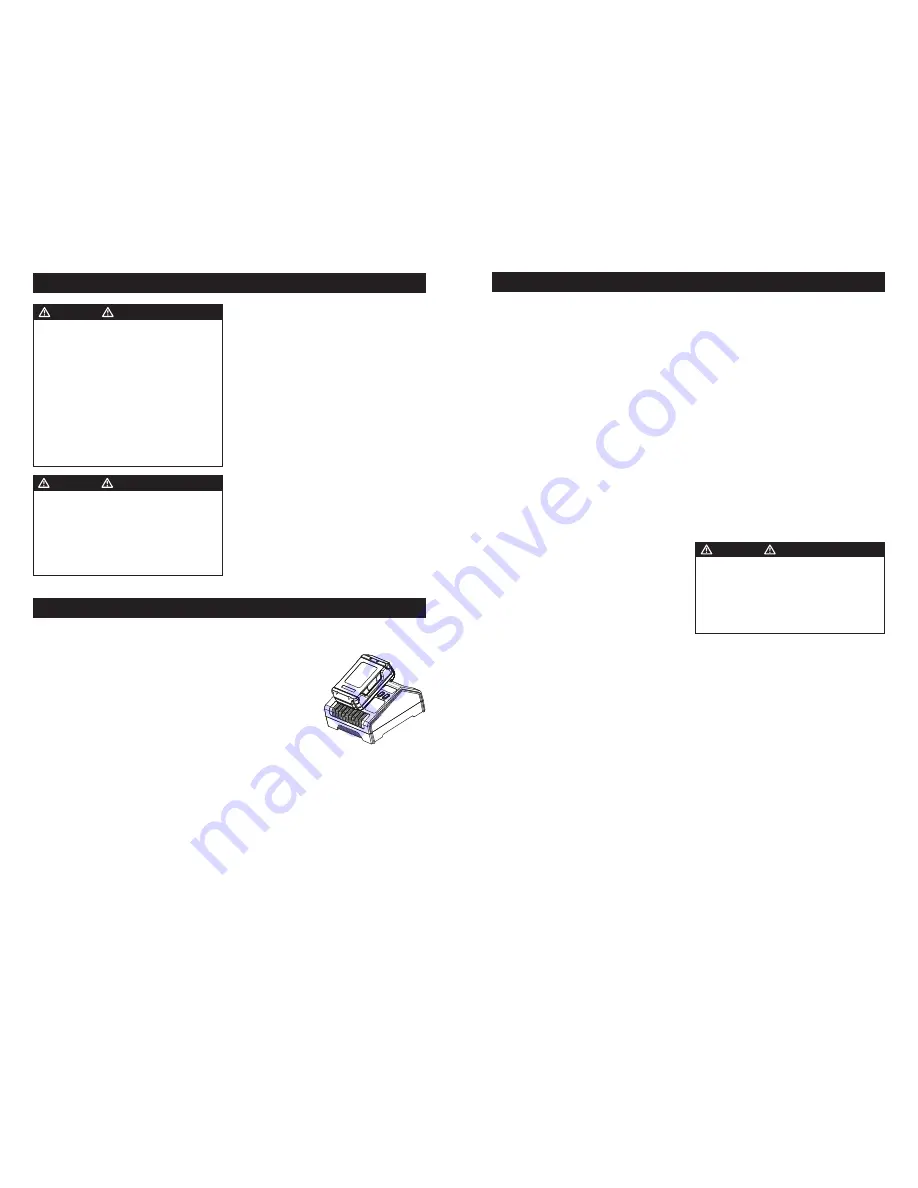
7
8
IMPORTANT SAFETY INSTRUCTION FOR BATTERY PACKS
WARNING
Fire hazard. Do not store or carry
battery so that metal objects can
contact exposed battery terminals.
For
example, do not place battery in aprons,
pockets, toolboxes, product kit boxes,
drawers, etc., with loose nails, screws,
keys, etc.
CHARGING PROCEDURE
Coleman
®
chargers are designed to charge
Coleman
®
battery packs in 1 - 2 hours depending
on the pack being charged.
1. Plug the charger into an appropriate outlet before inserting
the battery pack.
2. Insert the battery pack into the charger as shown in
figure A
.
3. The green LED will flash indicating that the battery is being
charged.
4. The completion of charge is indicated by the green LED
remaining on continuously. The pack is fully charged and may
be used at this time or left on the charger.
Recharge discharged batteries as soon as possible after use
or battery life may be greatly diminished.
For longest battery
life, do not discharge batteries fully. It is recommended that the
batteries be recharged after each use.
WARNING
Never attempt to open the battery pack
for any reason. If battery pack case is
cracked or damaged, do not insert into
charger. Do not crush, drop or damage
battery pack. Do not use a battery
pack or charger that has received a
sharp blow, been dropped, run over or
damaged in any way (i.e., pierced with
a nail, hit with a hammer, stepped on).
Damaged battery packs should be
returned to service center for recycling.
Transporting batteries can possibly cause
fires if the battery terminals inadvertently
come in contact with conductive materials
such as keys, coins, hand tools and the
like.
The US Department of Transportation
Hazardous Material Regulations (HMR)
actually prohibits transporting batteries in
commerce or on airplanes (i.e., packed in
suitcases and carry-on luggage) UNLESS
they are properly protected from short
circuits.
So when transporting individual batteries,
make sure that the battery terminals are
protected and well insulated from materials
that could contact them and cause a short
circuit.
NOTE: Lithium-Ion batteries should not be
put in checked baggage.
STORAGE RECOMMENDATIONS
1. The best storage place is one that is cool
and dry away from direct sunlight and
excess heat or cold.
2. Long storage will not harm the battery
pack or charger.
Figure A
CHARGER DIAGNOSTICS
This charger is designed to detect certain
problems that can arise with the battery
packs or the power source. Problems are
indicated by two LED flashing in different
patterns.
CHARGING PROCEDURE
1. The battery pack should be recharged
when it fails to produce sufficient power
on jobs, which were easily done previously.
DO NOT CONTINUE to use under these
conditions. Follow the charging procedure.
You may also charge a partially used pack
whenever you desire with no adverse
affect on the battery pack.
2. Foreign materials of a conductive nature
such as, but not limited to, steel wool,
aluminum foil, or any buildup of metallic
particles should be kept away from charger
cavities. Always unplug the charger from
the power supply when there is no battery
pack in the cavity. Unplug charger before
attempting to clean.
3. Do not freeze or immerse charger in water
or any other liquid.
LEAVING THE BATTERY IN THE
CHARGER
The charger and battery pack can be left
connected with the green LED glowing
indefinitely. The charger will keep the
battery pack fresh and fully charged.
IMPORTANT CHARGING NOTES
1. Longest life and best performance can be
obtained if the battery pack is charged
when the air temperature is between 65°F
and 75°F (18°- 24°C). DO NOT charge
the battery pack in an air temperature
below +40°F (+4.5°C), or above +105°F
(+40.5°C). This is important and will
prevent serious damage to the battery
pack.
2. The charger and battery pack may become
warm to touch while charging. This is a
normal condition, and does not indicate
a problem. To facilitate the cooling of
the battery pack after use, avoid placing
the charger or battery pack in a warm
environment such as in a metal shed, or an
uninsulated trailer.
3. If the battery pack does not charge
properly:
a. Check current at receptacle by plugging
in a lamp or other appliance.
b. Check to see if receptacle is connected
to a light switch which turns power off
when you turn out the lights.
c. Move charger and battery pack to a
location where the surrounding air
temperature is approximately 65°F -
75°F (18°- 24°C).
d. If charging problems persist, take the
tool, battery pack and charger to your
local service center.
WARNING
Shock hazard.
Do not allow any liquid to
get inside charger.
Never attempt to open
the battery pack for any reason. If the
plastic housing of the battery pack breaks
or cracks, return to a service center for
recycling.
BAD BATTERY
The charger can detect a weak or damaged
battery. The red LED flashes in the pattern
indicated on the label. If you see this bad
battery blink pattern, do not continue to
charge the battery. Return it to a service
center or a collection site for recycling.
CHARGER
This Class B digital apparatus complies with
Canadian ICE5-003.
This device complies with Part 15 of the FCC
Rules.
This ISM device complies with Canadian
ICES-001.
Operation is subject to the following two
conditions:
1. This device may not cause interference,
and
2. This device must accept any interference,
including interference that may cause
undesired operation of the device.

































